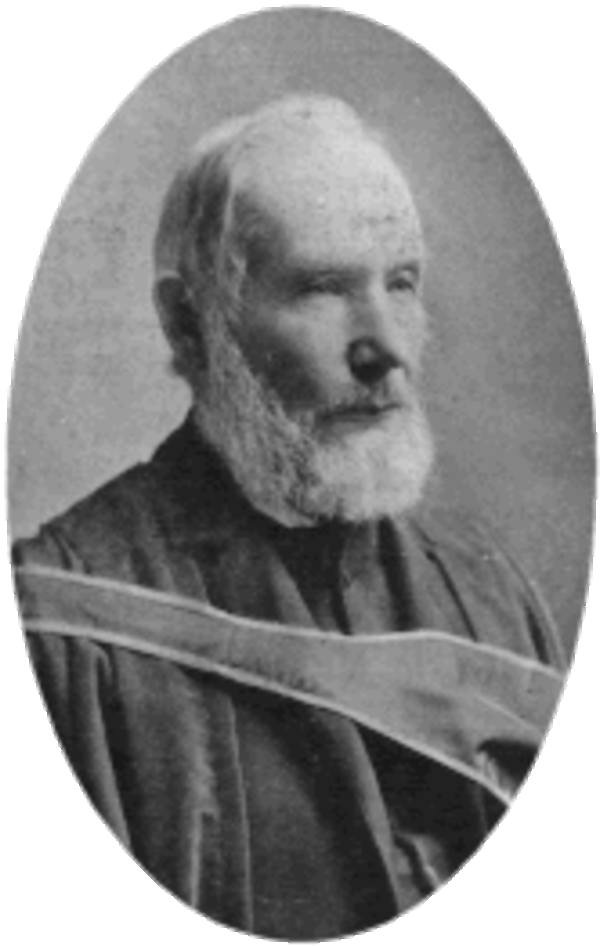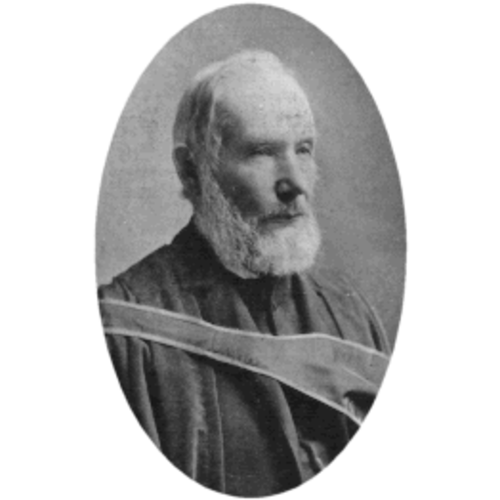
Source: Link
FOWLER, JAMES, Presbyterian minister, botanist, educator, and curator; b. 16 July 1829 in Bartibog, N.B., eldest child of George Fowlie and Jane McKnight; m. 1 July 1858 Mary Ann McLeod (d. 1890) of Truro, N.S., and they had two daughters; d. 11 Jan. 1923 in Kingston, Ont.
James Fowler’s surname was originally Fowlie. It is not known why or precisely when, as a young man, he adopted the name Fowler. His father and his mother’s family had emigrated from Scotland to eastern New Brunswick in 1816. George Fowlie eventually established a farm with a grist mill and sawmill at Little Branch on Miramichi Bay, and it was here that Fowler was raised. He might well have been expected, at age 14 and with eight younger siblings, to step into the breach created by the death of his father in 1843. It was evidently a remarkable mother who instead enabled him to attend the county grammar school at Chatham, and from 1850 to 1855 to pursue theological studies at the Free Church College in Halifax, where he took the prize in classics. After teaching for a short period in the academy connected with the college, he returned home and was ordained in 1857.
Fowler began his pastoral career in Black River in his native Northumberland County but shortly removed to Kouchibouguac in neighbouring Kent. In 1861 he took up a charge at Bass River, also in Kent. By this time he had become keenly interested in natural history and revealed a bent for collecting. His scope included geology, conchology, meteorology, and especially systematic botany. Over the next 15 years, while ministering to a far-flung and poor rural congregation, he immersed himself in study of the local and, later, provincial flora. The anchor of this activity, and of all his subsequent work in botany, was his herbarium. He was soon scouting widely for North American and overseas collectors through whom he could expand its taxonomic and geographic scope via exchanges – and relying on his wife to mount the large annual influx of specimens.
Although he corresponded with and twice visited the renowned botanist Asa Gray, of Harvard University, during his years at Bass River, Fowler’s chief early mentor in botany was George William Clinton of Buffalo, N.Y. A capable amateur botanist, distinguished judge, and president of the Buffalo Society of Natural Sciences, Clinton reviewed Fowler’s early identifications, sent him large collections, and provided moral support during a long-sustained correspondence. Fowler also made important scientific contacts in New Brunswick, especially with the geologists George Frederic Matthew and Loring Woart Bailey, both of whom published notable papers on the climatic and historical contexts of New Brunswick flora.
Late in 1875 Fowler wrote to Clinton that chronic laryngitis might compel him to “cease public speaking for some time, if not for life.” He resigned his pastorate in 1876, and spent the next two years in Saint John completing the first catalogue of New Brunswick vascular plants and bryophytes, which would be published by the province in 1879. In 1878 he was appointed instructor in natural science at the Normal School in Fredericton. His comment that the position did “not involve much speaking” is odd, but may reflect his adaptation of the program to his own style. He was nonetheless an influential and popular teacher. Several of his students and others inspired by his example made important local plant collections, and these would enable Fowler to publish a substantially revised catalogue of the provincial flora in 1885.
Fowler was appointed lecturer on natural science, librarian, and curator of the museum at Queen’s College in Kingston in 1880, and for the next 12 years he taught its courses in geology, botany, and zoology. He had been warmly recommended for the lectureship by Gray and Bailey, and was promoted to the rank of professor in 1891. With the creation of a professorship in animal biology and physiology in 1892, he gave up his duties in zoology, and after geology was removed to the new School of Mining and Agriculture in 1894, he became the university’s first full-time professor of botany. Fowler’s most notable achievement at Queen’s was the development of a major herbarium, building on the one he had brought with him from New Brunswick. Numbering nearly 50,000 specimens and probably more than 15,000 species by his retirement in 1907, it was at the time second in size and scope among Canadian herbaria only to that established at the Geological Survey of Canada by John Macoun*. He continued to collect intensively while at Queen’s, both in eastern Ontario and in the Maritimes, in large part to obtain material for use by his students. In 1900 and 1901, for example, he personally collected a total of more than 12,000 specimens at St Andrews, N.B., and Canso, N.S., using the mobile research station of the Marine Biological Stations of Canada as a base of operations.
While his record of published original research was modest, Fowler was widely respected for his prodigious knowledge of the flora of eastern North America. A maritime knotweed which he had first collected in New Brunswick in 1869 was named Polygonum fowleri in his honour by the Harvard botanist Benjamin Lincoln Robinson. Fowler’s meticulous and thorough work habits gave his identifications a high degree of reliability, and he was consulted especially on the naming of grasses and sedges. His student and eventual successor at Queen’s, William Thomas MacClement, noted that he “did not thrust himself or his work on the attention of the world. A man of greater modesty and less self-assertion could scarcely be found.” He was awarded two honorary degrees, ma (1872) and lld (1900), by the University of New Brunswick, and was elected to the Royal Society of Canada in 1891. That year he was invited to give the inaugural address at the opening of the Queen’s theological faculty, an acknowledgement of his stature in the Presbyterian community, and of his exceptional command of classical Hebrew, Greek, and Latin.
About 1904 Fowler began to experience significant memory loss. This progressed rapidly following his retirement at age 77. He remained physically active for many years, but soon recognized no one but his daughter Eliza Annie Law Fowler, who cared for him until his death at age 93. During the next half-century the emphasis in botany at Queen’s shifted to physiology, and the herbarium was neglected. It was revived and named the Fowler Herbarium in 1965, and since then has assumed an important role in modern research on plant systematics and conservation.
James Fowler’s reports as curator of the museum were published in the Queen’s Quarterly (Kingston, Ont.) from 1893–94 to 1905–6. His other publications include: “List of New Brunswick plants,” N.B., Secretary for agriculture, Report (Saint John), 1878, app.B: 35-63; “Additions to the list of New Brunswick plants [continued from last year’s report],” N.B., Secretary for agriculture, Report, 1879; “Geology of the Maritime provinces” and “Useful minerals of the Maritime provinces,” in F. B. Roe, Atlas of the Maritime provinces of the Dominion of Canada . . . (Saint John and Halifax, 1879), 8-13 and 13-14; “Preliminary list of the plants of New Brunswick,” N.B., Natural Hist. Soc., Bull. (Saint John), no.4 (1885): 8-84; “Arctic plants growing in New Brunswick, with notes on their distribution,” RSC, Trans., 1st ser., 5 (1887), sect.iv: 189–205; “Vegetable physiology,” Queen’s Quarterly, 3 (1895–96): 199–208; “How plants use animals: a chapter in ecology,” Queen’s Quarterly, 6 (1898–99): 188–203; “Report on the flora of St. Andrew’s, N.B.,” Contributions to Canadian Biology (Toronto), [1] (1901): 41–48; and “Report on the flora of Canso, Nova Scotia,” Contributions to Canadian Biology, [2] (1902–5): 59–70.
Buffalo Soc. of Natural Sciences Arch. (Buffalo, N.Y.), Papers of George William Clinton, Fowler to Clinton, 25 July 1865–22 Feb. 1879. Library of the Gray Herbarium Arch., Harvard Univ. (Cambridge, Mass.), Historic letter coll., Fowler to Asa Gray, 12 Oct. 1870–22 May 1880. N.B. Museum (Saint John), W. F. Ganong fonds, Fowler to L. W. Bailey, 8 June 1865; 28 Jan., 23 Feb., 27 Sept. 1867; 27 April, 18 May, 8 Dec. 1869; Fowler to G. F. Matthew, 10 Dec. 1866; Fowler to Ganong, 6 June 1904; W. T. MacClement to Ganong, 3 Jan. 1918. Private arch., G. F. MacMillan (Bathurst, N.B.), Geneal. of the Fowlie family. QUA, Office of the University Secretariat fonds, Queen’s Letters ser., James Fowler, application and testimonials, 1880, locator no.1244. Daily Telegraph (Saint John), 17 Sept. 1880. R. E. Beschel, A history of the biology department and the Fowler Herbarium of Queen’s University, summarized for the opening of Earl Hall on May 19, 1966 ([Kingston, 1966]) (copy at QUA, Dept. of biology fonds); “Presenting: some early history of the biology department,” Queen’s Rev. (Kingston), 40 (1966): 92–99. Bernard Boivin, Survey of Canadian herbaria (Quebec, 1980), 86. Canadian men and women of the time (Morgan; 1912). A. A. Crowder, “The collection of bryophytes in the Fowler Herbarium, Queen’s University, Kingston, Ontario,” Canadian Field-Naturalist (Ottawa), 88 (1974): 47–55. W. D. Hamilton, Dictionary of Miramichi biography; biographical sketches of men and women born before 1900 who played a part in public life on the Miramichi: Northumberland County, New Brunswick, Canada (Saint John, 1997), 130–31. W. T. MacClement, “‘The makers of Queen’s’: James Fowler, m.a., ph.d., f.r.s.c.,” Queen’s Rev., 2 (1928): 2–4. D. P. Penhallow, “A review of Canadian botany from 1800 to 1895, part ii,” RSC, Trans., 2nd ser., 3 (1897), sect.iv: 1–56. B. L. Robinson, “The New England Polygonums of the section Aviculare,” Rhodora (Boston and Providence, R.I.), 4 (1902): 65–73. B. N. Smallman et al., Queen’s biology: an academic history of innocence lost and fame gained, 1858–1965 (Kingston, 1991). Who’s who (London), 1912.
Cite This Article
Stephen R. Clayden, “FOWLER, JAMES,” in Dictionary of Canadian Biography, vol. 15, University of Toronto/Université Laval, 2003–, accessed December 17, 2025, https://www.biographi.ca/en/bio/fowler_james_15E.html.
The citation above shows the format for footnotes and endnotes according to the Chicago manual of style (16th edition). Information to be used in other citation formats:
| Permalink: | https://www.biographi.ca/en/bio/fowler_james_15E.html |
| Author of Article: | Stephen R. Clayden |
| Title of Article: | FOWLER, JAMES |
| Publication Name: | Dictionary of Canadian Biography, vol. 15 |
| Publisher: | University of Toronto/Université Laval |
| Year of publication: | 2005 |
| Year of revision: | 2005 |
| Access Date: | December 17, 2025 |



